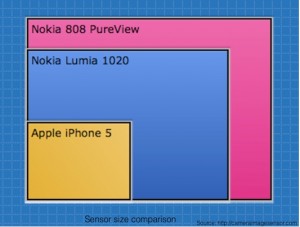It is very usual to presume that the more the number of megapixels the manufactures quotes on their smartphone or digital camera, the better the quality of a camera. In-fact while advertising the smartphones in the open market the manufactures even quote smartphones better than the digital SLR cameras. This assumption of having more megapixels gives a better quality image in very misleading. The megapixel measure gives you rough idea of how big the picture you are capturing in. It is not the only factor in deciding the quality of the image the camera is going to capture.
 Nokia smartphone Nokia 808 PureView holds the highest megapixel camera with 41 megapixels count in the market today. The technology that is being used by Nokia to bring in 41 megapixel camera is called oversampling. Using software Nokia takes one pixel and creates multiple pixels on the image sensor. This kind of image with 41 megapixels is useful when you want to print a big image on a hoarding where you enlarge the 5 megapixel image by oversampling it.
Nokia smartphone Nokia 808 PureView holds the highest megapixel camera with 41 megapixels count in the market today. The technology that is being used by Nokia to bring in 41 megapixel camera is called oversampling. Using software Nokia takes one pixel and creates multiple pixels on the image sensor. This kind of image with 41 megapixels is useful when you want to print a big image on a hoarding where you enlarge the 5 megapixel image by oversampling it.
One of the most important part of a camera which decide the quality of a picture is the image sensor. It is that part of the camera where light falls through the lens. The picture is formed on the image sensor plate. The sensor size also plays an important role. Bigger the sensor size, more detailed will be the image. The quality of the image will not distort even if you crop into smaller parts and of enlarge it.
However the more you try to pack the pixels into the image sensor than its size, the picture gets blurry. Managing a correct balance between the image sensor size and still making the camera compact is where the manufactured struggle to balance. The more you increase the size of an image sensor; the camera size will also increase. Not to blame only the manufactures, we also need a slim camera and with the requirement of longer battery life and high performance smartphone they will have to compromise on some or the other things. The easy way to do is to have a smaller sensor and compromise on the lens.
While selecting a camera one should look for not only megapixels but look for two most important things; one is the sensor size of the device and another important thing is the ISO setting or the sensitivity of a camera. Higher the ISO setting means you will be able to take picture even in poor lighting. The current trend in Low-light photography will make user to look for better lenses going forward. Also the aperture and the size of the lens are very important in low light photography. An aperture of f2.2 or f1.8 is good enough for compact cameras. Megapixel plays hardly any role in the low light scenario.
It is seen that a normal 8 megapixel camera is good enough to print a good quality image on a A4 size paper. This will help in making the smartphone a super compact. So the next time you what to buy a camera or a smartphone make sure you read the ISO settings and the image sensor size specifications too and not only megapixel count.
